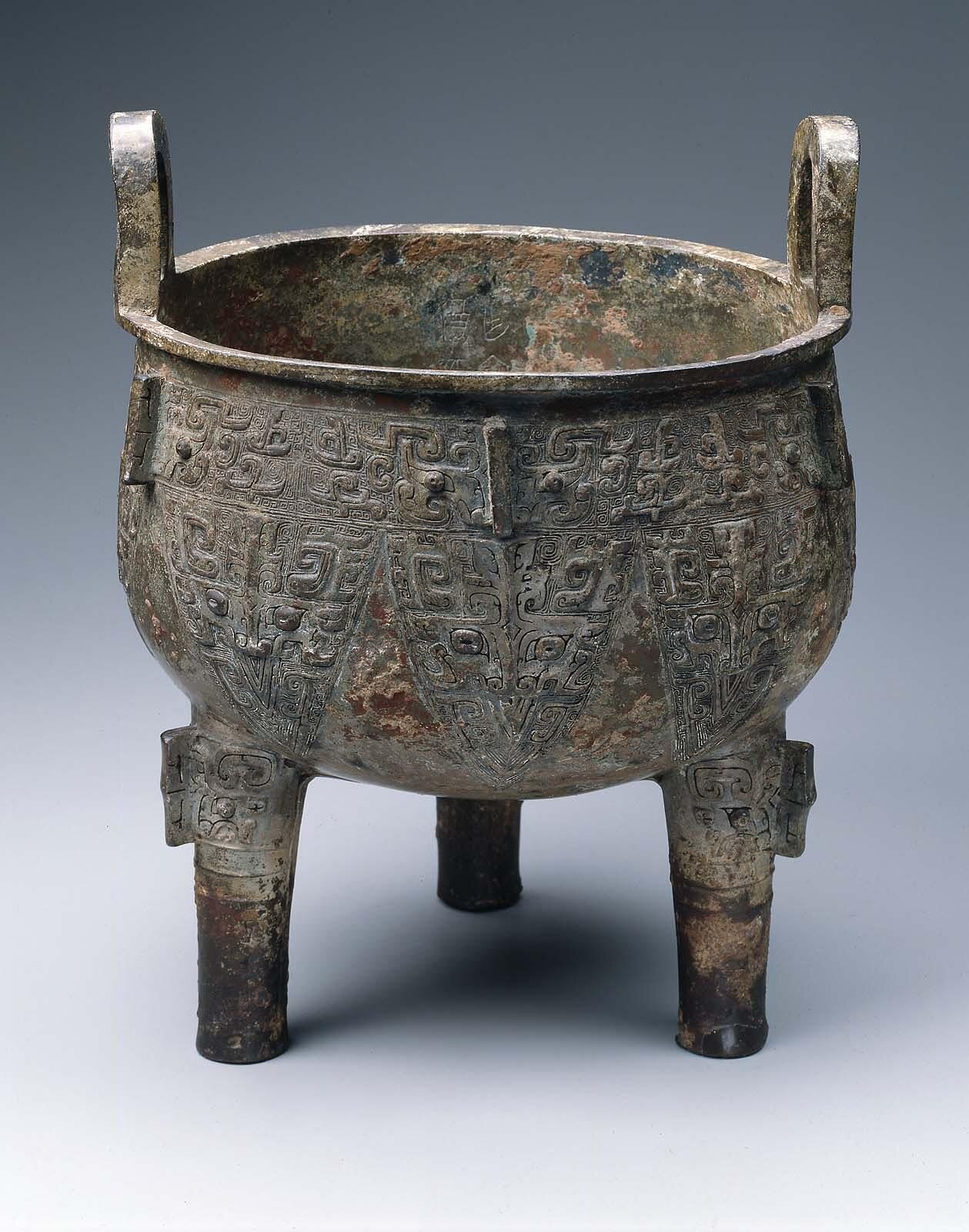The Material World of the Chinese Bronze Age
By Sophia Yakumithis
Ritual food vessel (ding), Early Western Zhou dynasty, late 11th century B.C.E., cast bronze, Museum of Fine Arts Boston. Image courtesy of mfa.org.
Incorporating techniques from its Shang predecessors, the Western Zhou dynasty culminated with the prior as the Chinese Bronze Age and established a tremendous material culture of bronze works from 2,000 to 771 BCE. Just around the corner, Boston’s Museum of Fine Arts is home to a robust collection of these Chinese bronzes.
The most commonly produced bronzes during the Western Zhou dynasty came in the form of vessels, although other objects included grandiose chariot decorations and fierce weaponry. Historians generally agree that Chinese vessels served as a representation of authority and divine rulership, especially considering that Shang and Western Zhou kingships were largely evaluated on one’s ability to appropriate precious metals for ceremonies; highly stylized patterning emphasized this notion. A key feature of Shang ritual art is the taotie motif, a frontal, zoomorphic mask depicting eyes in high relief and flared nostrils. This motif also predominated the design aspects of Western Zhou vessels known as dings, three to four-legged cauldrons used for food rituals.
Taotie motif diagram
One example of these vessels at the MFA, as pictured below, showcases the taotie motif at its apex. Beginning with the patterning depicted on the exterior of the ding, the two-eyed taotie dominates the surface of the basin. Arranged in alternating triangles, the face of three zoomorphic figures stand out when looking at the tripod head on; however, the motif does wrap around the entire cauldron. Above the central taotie, which occupies a vertical surface area of the upper two-thirds of the basin, is a prominent band segment lining the relief just below the cauldron’s rim. The relief also exhibits the taotie, represented by two, button-like pieces of cast molding on either side of a protruding ear piece. For the viewer, this could be interpreted as two round eyes on either side of a three-dimensional, rectangular nose. This image appears four times around the circumference of the ding’s mouth: just below each handle and at either meridian point.
The taotie figure depicted on the relief band differs from those on the vessel’s foreground in that the latter was rendered with engraved patterning as opposed to built out of cast bronze pieces. In other words, the predominating motif displays a more complex visual design than those on the relief band. The triangular taoties around the basin are also more complex in their expressions, exhibiting eyes with sharp inner and outer apexes in high relief, and flared nostrils resembling upside-down Ionic columns capping off their narrow noses. This expression denotes a sense of alertness to the viewer. The facial qualities of the triangular taoties are surrounded by abstract, leaf-like patterns which essentially fill the taoties’ faces, fitting the emphasis on grandeur which was associated with the Western Zhou period. Slight imperfections in their symmetry implies that this engraving was done by hand, perhaps as a reflection of the artists’ abilities to employ complex decorative methods to highly coveted bronze works. An inscription on the vessel’s interior furthers this assumption. This would therefore deem the expression of the zoomorphs and their iconographic values as completely incidental and a great contrast to the refinement of late Western Zhou bronze work. However, most scholars agree that the taotie constituted at least relative importance in ceremonial or ritualistic settings; given that this ding was specifically intended for ritual, that theory is likely correct.
Ritual vessels from the Shang period commonly exhibited bladelike legs with greater proportional variations than those of the Western Zhou style. Indeed, the latter is strongly associated with large structural proportions, a symbolic representation of the centrality of power and capacity maintained in the Western Zhou period. The ding’s deep basin is supported by three thick, cylindrical legs. Each leg is slightly shorter than the bowl itself in length, and displays a simple yet stylized pattern along the top third where the legs and the bowl connect. This pattern is identical to the one depicted on the band segment mentioned earlier, enabling a sense of continuity between the two mechanisms. Strategically connected to the legs’ top third is also a protruding ear piece which, again, appears on the aforementioned band segment. Although small in size, the ear piece is greatly significant in that it foreshadows a crucial Western Zhou development in bronze casting, which is the buttressing of separate pieces to give ritual objects a three dimensional, commanding presence.
The length of each leg is essentially an unremarkable characteristic of the ding in terms of aesthetic quality. However, a functional connotation exists in the proportions respective to the cauldron’s body: the basin is deep and rounded while the legs are sturdy, fortifying the ding during ritualistic practices. The emphasis placed on each legs’ structural properties as opposed to their visual attributes is paramount to identifying the stylistic components and cultural values manifested in the shift from Shang to Western Zhou style ritual vessels.
As we can see from this specific early Western Zhou ritual vessel, artistic developments from the Shang era set the foundation for the Chinese Bronze Age. Refinement of techniques and shifting cultural values, however, increased the complexity of both the means of production and material importance, leading to some of the most beautiful works produced during the Western Zhou dynasty.


